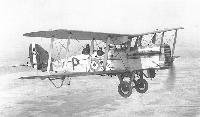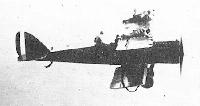Книги
Putnam
P.Jarrett, K.Munson
Biplane to Monoplane: Aircraft Development, 1919-39
24
P.Jarrett, K.Munson - Biplane to Monoplane: Aircraft Development, 1919-39 /Putnam/
The uncovered airframe of the Avro 504K, a typical wood-and-fabric braced biplane of the 1912-30 period. This form of structure remains in use for light aircraft today.
Frank Barnwell's F2B, the famous Bristol Fighter, typifies the state of the art in 1917: a relatively efficient 275hp Rolls-Royce Falcon engine dragging lightly loaded biplane wings and a mass of struts, wires and other excrescences behind it. This Mk.II, with tropical equipment and the Handley Page automatic slats fitted in 1928, had a maximum speed of only 110mph (177km/h).
One of the earliest uses of air transport was the carriage of casualties. Here, a Bristol Fighter has been pressed into service in the Middle East to carry a casualty encased in the specially designed Neil Robertson stretcher; strapped to the rear fuselage top-decking.
Factory interior on July 21, 1924, showing large-scale production of steel tube fuselages for use on rebuilt WW-I De Havilland 4 observation aircraft.
American companies such as Boeing produced few new aircraft in the early 1920s, Reconditioning contracts, such as this DH-4 rebuild, were vital to the company's survival, and as the original wire-braced wooden fuselages were replaced by welded steel-tube structures, the company gained valuable early experience with metal structures. By the end of the decade, however, Boeing was a market leader.
American companies such as Boeing produced few new aircraft in the early 1920s, Reconditioning contracts, such as this DH-4 rebuild, were vital to the company's survival, and as the original wire-braced wooden fuselages were replaced by welded steel-tube structures, the company gained valuable early experience with metal structures. By the end of the decade, however, Boeing was a market leader.
An Airco D.H.9A of the RAF over Iraq. A wartime bomber design, its general-purpose use continued into the early 1930s, as it did with the similiar licence-built DH-4B and 4M in the US Services.
The H.P.20 research monoplane at Cricklewood in 1921. The fuselage, undercarriage and tail unit were those of the Westland-built D.H.9A F1632.
This modified D.H.9A, later designated Handley Page H. P20, is fitted with an early example of the Handley Page slotted wing.
This modified D.H.9A, later designated Handley Page H. P20, is fitted with an early example of the Handley Page slotted wing.
The aeroplane began ils purposeful parachuting career as a platform for aircrew training descents. Here, two pupils lie on the upper wing of a USAAS USD-9A. At a signal from the instructor in the rear cockpit they will pull their ripcords and be dragged into the air by their deploying parachutes.
RAF aircraft serving in the Middle East in the 1920s were provided with an aerial mast which could be erected in the event of a forced landing in hostile territory, to enable the crew to summon assistance. This Airco DH.9A of No 8 Squadron, piloted by Sergeant Beaumont, came down at Al Maleppo on the French Assyrian border in 1926, and was recovered to fly again.
The four-passenger Airco/de Havilland D.H.16 operated Aircraft Transport and Travel's first cross-Channel scheduled passenger service, on 25 August 1919.
Passenger entry to the cabin of the D.H.16 was similar to that of the D.H.4A - via an external ladder and hinged roof.
Passenger entry to the cabin of the D.H.16 was similar to that of the D.H.4A - via an external ladder and hinged roof.
Heavy protective clothing was essential for those prepared to brave the elements in lhe open cockpits of such war-surplus 'transports' as this converted Airco D.H.9 bomber.
A Felixstowe F5 flying boat in early 1925, fitted with a Saunders patent hollow-bottomed hull as one of the many different hull forms tried in the early stages of development of the flying boat genus.
HandLey Page O/10 O/400 conversion G-EATL was one of the aircraft used by HandLey Page Transport after the company began scheduled cross-Channel services in September 1919.
Spectators race to the scene at St John's, Newfoundland, on 18 May 1919, moments after test pilot F P Raynham, with navigator Captain C W F Morgan, crashed in the Martinsyde Raymor while taking off to attempt the first direct Atlantic air crossing
The aircraft industry's initial phase of expansion occurred during the First World War. By 1918 the most successful British company of this era, Sopwith, was producing aircraft like these Snipes and Salamanders in very large numbers.
The aircraft industry's initial phase of expansion occurred during the First World War. By 1918 the most successful British company of this era, Sopwith, was producing aircraft like these Snipes and Salamanders in very large numbers.
Alcock and Brown's Vickers Vimy on Lester's Field, St John's, Newfoundland, shortly before its departure for its epic transatlantic flight on 14 June 1919.
The sleel-tube fuselage and tail structure of the Fokker D.VII fighter of 1918. The heavily cambered, ply-skinned wooden wing adopted by Fokker during the war was employed in his company's successful series of interwar airliners.
The Junkers F 13 was the first aIl-metal airliner to be put into production. Luft Hansa's Nachtigall (Nightingale) is seen at Berlin-Tempelhof. D-1 is believed to have been the first F 13, although originally registered D-183.
A Junkers F 13 of Swiss airline Ad Astra Aero displays the distinctive Junkers corrugated metal skinning, retained throughout the interwar years. The loss of a British registered F 13 in a crash at Meopham, Kent, on 21 July 1930 was one of the first recognised cases of structural failure due to metal fatigue.
Prevented by the Treaty of Versailles from producing military aircraft, Germany turned instead to civil aviation. The Junkers F 13 was one of the most widely used civil transport aircraft in the world during the 1920s.
'One of the most alarming and unstable machines ever to attempt a maiden flight', the Curtiss HA hydroaeroplane was tamed by the masterly handling of tyro test pilot Roland Rohlfs.
The Martin MB-2 night-bomber of 1920, like a number of US and British aircraft of the period, used US Liberty engines. The MB-2 configuration was employed in many subsequent bomber designs.
In was in his report on a Packard-Le Pere LUSAC-11, in 1918, that lanky American Rudolf W Schroeder, working from his kneeboard notes, achieved 'a major step forward in the development of American flight test methods and research'.
Two of the Farman Goliaths which gave French airlines competitive advantage in the early 1920s. Beyond are a KLM Fokker F.III and Air Union Bleriot-Spad 33 F-ADBl. The Goliaths illustrated also belonged to Air Union and were named Languedoc and Normandie. Goliaths were the first to have white-topped fuselages.
Two standard Salmson-powered Farman F.60 Goliaths of Air Union at Le Bourget. These aircraft are F-ADDT Languedoc and F-AECU Normandie. F-ADDT was light buff in colour and F-AECU dark buff. Both had white fuselage tops and white upper surfaces to the top wing. The other aircraft are the Blériot Spad 33 F-ADBI of Air Union and Fokker F.III H-NABG of KLM.
Two standard Salmson-powered Farman F.60 Goliaths of Air Union at Le Bourget. These aircraft are F-ADDT Languedoc and F-AECU Normandie. F-ADDT was light buff in colour and F-AECU dark buff. Both had white fuselage tops and white upper surfaces to the top wing. The other aircraft are the Blériot Spad 33 F-ADBI of Air Union and Fokker F.III H-NABG of KLM.























